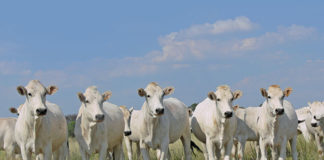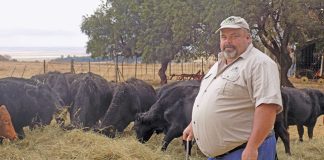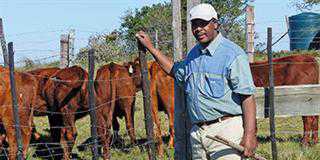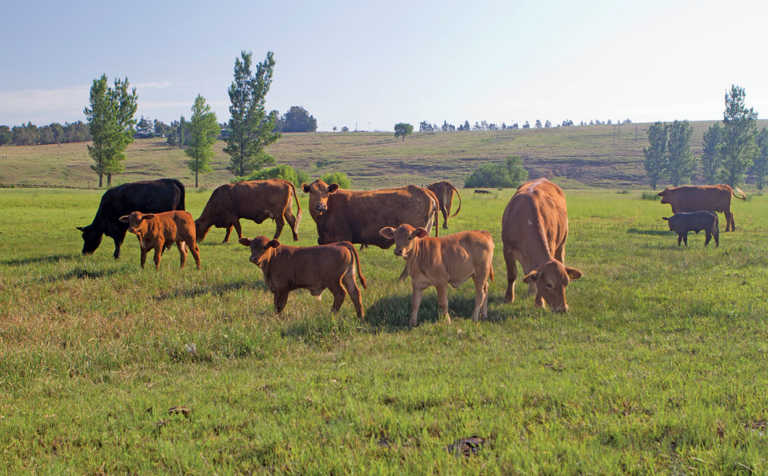
Photo: Sabrina Dean
The bakkie bounces along through the sourveld grazing camp. The prevalent red grass, Themeda triandra, looks lush and healthy, thanks to the mist belt conditions on the farmland surrounding the tiny village of Swinburne in the Free State.
Ahead is a cow with her young calf. Stockman Bongaan Ncama jumps off the bakkie and quickly gets hold of the calf, only a few hours old but already strong and lively.
READ Lucerne: A massive export market for ‘green gold’
This ritual takes place at the birth of every calf on the farm. The colour is recorded and the animal is sexed, tagged and weighed. Within hours of its birth, breeder Christopher Sparks will have laid hands and eyes on the latest addition to his award-winning Brangus stud herd.
Sparks, one of the top Brangus breeders in South Africa, won two awards in 2018: the Agricultural Research Council’s (ARC) Beef Improvement Herd of the Year, and the Breedplan Stud Producer of the Year.
Buying back the family farm
Sparks grew up riding and hunting on the rolling hills surrounding Swinburne. His family owned most of this farmland, as well as the village itself, until his grandmother sold it off following her husband’s death.
In the late 1990s, Sparks bought back his first plot of this land, a 1,8ha smallholding called Mount Olive Stables, where he kept his beloved Arabian horses.
Over the years he gradually acquired additional pieces of the farmland, and today has reclaimed much of the farm that once belonged to his family. An architect by trade, he runs his firm from an office he has established in the town.
His cattle component consists of the Mount Olive Brangus Stud and a Nguni conservation breeding and weaner production operation utilising stud-quality cows. In addition, he has his Mount Olive Arabian Stud and has recently purchased a herd of Xhosa Lob Ear indigenous veld goats.
Measure for success
As an architect, Sparks adopts both a scientific and creative approach to business. This is evident in his approach to cattle farming, which combines the application of science-based tools with the artistry inherent in a stud breeder trying to breed a beautiful animal.
As an interesting example of this, he breeds for ears. The large ears on the Brangus calves, he explains, are a sign of their Brahman ancestry and an indication of the presence of certain desired breed attributes such as temperament and mothering ability.
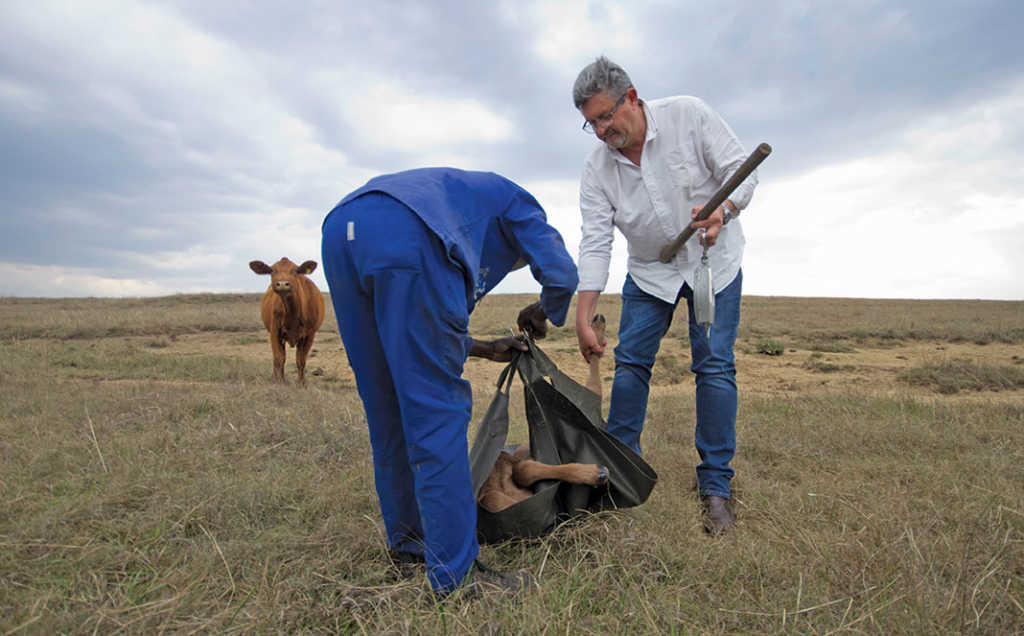
At the same time, he employs ultrasonic scanning technology to evaluate the ribeye muscling of his bulls. This cannot be accurately determined by visual appraisal, yet he considers it an essential selection trait in breeding his ideal beef animal.
“It’s important to know what’s going on under the hide of the animal,” he says.
Sparks introduced ultrasonic scanning in 2011 in collaboration with the ARC, and the process is run in conjunction with a veld bull test he has conducted annually since 2009.
This test is administered by the Veld Bull Club of South Africa and runs over five months.
The weaners graze the veld during the summer months until they are 16 months old, and are fed 1kg of production lick a day for the duration of the test.
Nothing is changed over this period, except that the animals are measured once a month for weight gain, muscling and hair loss. This provides an opportunity to analyse temperament, which Sparks believes correlates directly with meat tenderness.
The test also enables him to identify the bulls that are best adapted to his environment and needs. Data is processed into an economic index by the Veld Bull Club, which he then adds to other data he collects for processing through Breedplan.
This gives him information on carcass traits and other relevant estimated breed values.
He generally uses the finest breeding bulls (measured in terms of performance and breed data) for only a single season. His aim is first and foremost to breed a bull that is better than its sire.
‘Low-maintenance factories’
Sparks wants his bulls to produce daughters which grow into cows that are “low-maintenance factories”.
He aims for an animal that is well adapted to performing on his sourveld grazing conditions, which will also eventually convert to rands and cents in the pockets of commercial producers.
“If they’re doing well on sourveld, imagine how they’ll perform on sweetveld!” he says.
Adaptability and fertility are among his most important selection criteria for cows. He also demands optimal birthweights, high milk volumes, and most importantly, excellent maternal ability, with dams capable of looking after their calves on the veld.
READ Beefing up cattle using the continuous grazing system
His herd conception rate is approximately 95%. A heifer gets only one chance to produce a calf; if she fails, she is culled.
That said, she gets a fair chance to book her place in the Mount Olive Stud herd: all heifers are grown out for two years before breeding to improve the likelihood of conception. Heifers are then synchronised and undergo artificial insemination (AI) in October.
Sparks uses AI on a female only once in her lifetime in order to allow for synchronisation with other heifers.
Once a cow has calved down for the first time, she is placed in her appropriate herd and in future bred to specific bulls during the main breeding season from December to February.
Breeding for quality beef
The Brangus herd comprises approximately 80% red animals and 20% black. Although Sparks remains convinced that the black animal is the better of the two, he recognises that red animals are still favoured in South Africa, and hence are more marketable.
He believes that, contrary to perception, black cattle fare better in South African conditions as their darker coats help them control body temperature more effectively.
The red coat colour is due to a recessive gene in the black cattle, created from a cross between Angus and Brahman cattle. According to Sparks, it is possible to produce a red calf from a black-on-black crossing, but two red Brangus cattle will not produce a black calf.
READ Extending artificial insemination to beef cattle
He believes the genetic base of the black animals counts in their favour and says that the selection pressure on his black cattle is heavier than on red animals. This means that his black herd is also improving at a faster rate.
The visual appearance of his cattle is extremely important to Sparks. All animals must be phenotypically correct and pass a breed society screening based on minimum standards.
He also invests a great deal in fact-based parent verification.
“I’ve spent a lot of money to get DNA profiles on all of my cows,” he says.
Tail hairs are collected and parent verification is carried out on animals that are put through the veld bull test.
Sparks says that at the end of the day, he simply tries to produce animals that will deliver a high volume of good-quality meat for the end-consumer.
The problem that he and most red meat producers face, however, is getting value for quality production.
To address this, it is necessary, in his opinion, to introduce a grading system that runs in conjunction with the existing classification system.
“You get tired of taking care to produce something of premium quality, only to see it get lumped into a cauldron with everything else,” he says.
Phone Christopher Sparks on 083 701 0029, or email him at [email protected].









